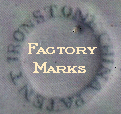

Mason's & Other Ironstone China Wares
The word IRONSTONE was introduced in 1813, it was the Mason family who on developing potting techniques,
registered the patent name, other factories were already producing this type of ware but it was Miles Mason's
youngest son Charles James Mason who at 21 years of age took out the patent No 3724 31st July 1813 a process
for the "Improvement of the Manufacture of English Porcelain', IRONSTONE PATENT CHINA"
The process, according to the specification consisted of using Scoria Slag
of Ironstone, pounded and ground in
water in certain proportions with flint, Cornwall stone, clay and blue oxide of cobalt, the origin of the word
IRONSTONE is evident from this specification PATENT IRONSTONE CHINA it was an extremely tough greyish,
porcellanous stoneware, because of its strength and durability, suitable for everyday domestic use and for export.
The patent was granted for a period of fourteen years and was not renewed, probably because the other major
potters had perfected their own ironstone body recipes.
IRONSTONE was an immense success, the name itself was commercially identifiable. Publicity was very important
to Mason's as the main feature of their sales policy was to sell to the public through auctions, before this auctions
had only been used to dispose of surplus and bankrupt stock.
Their production of IRONSTONE right from its the earliest pieces reached extraordinary levels of technical and
artistic excellence. The combining of rich colours like mazarine blue, brick red, and bright gilding, created a strong
effect.
New bodies an earthenware called Cambrian Argil' and Felspar' porcelain were added to production, approxi-
mately a hundred and twenty patterns a year were being introduced, by 1840 the table ware numbered over three
thousand patterns. Bisque' porcelain ,'Bandana' ware and White Ironstone were also introduced into the production,
the White Ironstone was primarily being made for the American market. Not all of these new products proved
successful and in 1848 Charles James Mason was declared bankrupt.
Charles made a brief attempt to revive his business at the Daisy Bank Pottery to coincide with the Great Exhibition
of 1851 but his last years were not prosperous, having sold out to Francis Morley, Charles James died in 1856
exhausted and broken by the irreversible decline in his fortunes.
Francis Morley acquired the Mason's designs and moulds and continued to produce Ironstone. He entered into a
partnership with Taylor Ashworth until 1861 when he retired. Taylor Ashworth's father George then acquired the
firm, and the trading title remained the same although different ownerships took place.
In 1884 John Shaw Goddard acquired the firm, producing traditional ware. In 1910 John's son John Vivian Goddard
started to experiment in decorative glazed lustre ware. 'Lustrosa' and 'Estrella' ware, were the new and exciting
products, they soon became known for their excellence and were described as 'highly artistic', and were exhibited
at the Lourve in Paris in 1914, unfortunately due to the outbreak of the war, production ceased.
In 1930 John Vivian Goddard repurchased the Ashworth company and a few pieces of 'Lustrosa' ware reappeared,
today they are extremely rare.
During 1922, ' Amber Glaze' ware was introduced to production, it was described as 'a ground colour of the ware
is a soft pale Ivory and the colouring unusually fine'. It was based on the reproduction of Georgian originals, in
'Romney', 'Gadroon' and 'Milburn'shapes. Pattern number C.2484 'Minuet', was the first pattern used on Amber
Glaze, 'Pink Vista', 'Langley', 'Mandarin', 'Oakland' and many others followed.
John Vivian Goddard died in 1962, his son John Stringer Goddard continued production. In 1969 he reversed the
Ashworth name to 'Mason's Ironstone China' the company was sold to the Wedgwood Group in 1973 and in 1981
John retired.
In 1998 production at the Hanley factory ceased, and the premises were demolished.
It was the end of an era for one of the most famous names in the history of English Ceramics.
For further information, our Web Site, current stock, events calendar, patterns & marks CLICK on the
buttons below
  |